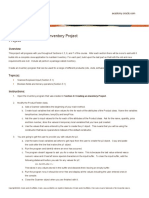Java 2
Uploaded by
Mrabet MustaphaJava 2
Uploaded by
Mrabet MustaphaCertainly, here's another Java exercise that involves classes, inheritance, error
handling with try-catch, arrays, and array sorting. In this exercise, we'll create
a simple product inventory management system with three classes: Product,
Inventory, and InventoryManager. Products can be added, removed, and sorted by
price.
java
Copy code
import java.util.Arrays;
import java.util.Comparator;
class Product {
private String name;
private double price;
private int stockQuantity;
public Product(String name, double price, int stockQuantity) {
this.name = name;
this.price = price;
this.stockQuantity = stockQuantity;
}
public String getName() {
return name;
}
public double getPrice() {
return price;
}
public void setPrice(double price) {
this.price = price;
}
public int getStockQuantity() {
return stockQuantity;
}
public void setStockQuantity(int stockQuantity) {
this.stockQuantity = stockQuantity;
}
@Override
public String toString() {
return "Product [Name: " + name + ", Price: $" + price + ", Stock Quantity:
" + stockQuantity + "]";
}
}
class Inventory {
private Product[] products;
private int productCount;
public Inventory(int maxProducts) {
this.products = new Product[maxProducts];
this.productCount = 0;
}
public void addProduct(Product product) {
if (productCount < products.length) {
products[productCount] = product;
productCount++;
} else {
System.out.println("Error: The inventory is full. Cannot add more
products.");
}
}
public void removeProduct(String productName) {
for (int i = 0; i < productCount; i++) {
if (products[i].getName().equals(productName)) {
for (int j = i; j < productCount - 1; j++) {
products[j] = products[j + 1];
}
products[productCount - 1] = null;
productCount--;
return;
}
}
System.out.println("Error: Product not found in the inventory.");
}
public Product[] getProducts() {
return Arrays.copyOf(products, productCount);
}
}
class InventoryManager {
public static void sortProductsByPrice(Product[] products) {
Arrays.sort(products, Comparator.comparingDouble(Product::getPrice));
}
public static void main(String[] args) {
// Create an inventory
Inventory inventory = new Inventory(5);
// Add products
inventory.addProduct(new Product("Laptop", 800.0, 10));
inventory.addProduct(new Product("Smartphone", 500.0, 15));
inventory.addProduct(new Product("Tablet", 300.0, 20));
// Remove a product
inventory.removeProduct("Tablet");
// Sort products by price
Product[] sortedProducts = inventory.getProducts();
sortProductsByPrice(sortedProducts);
System.out.println("Inventory Products:");
for (Product product : inventory.getProducts()) {
System.out.println(product);
}
System.out.println("\nInventory Products (Sorted by Price):");
for (Product product : sortedProducts) {
System.out.println(product);
}
}
}
In this exercise, we have three classes: Product, Inventory, and InventoryManager.
Products can be added, removed, and sorted by price. The InventoryManager class
provides a method to sort products by price and demonstrates the use of try-catch
blocks to handle exceptions when attempting to remove a product that doesn't exist
in the inventory.
You might also like
- Ooad Java PBL Report G7 by Gautam, Kartik, Pratyasha, AradhyaNo ratings yetOoad Java PBL Report G7 by Gautam, Kartik, Pratyasha, Aradhya41 pages
- Introduction to a Shopping Management System MicroprojectNo ratings yetIntroduction to a Shopping Management System Microproject12 pages
- M A J U O O P (OOP) G A 5: Raded SsignmentNo ratings yetM A J U O O P (OOP) G A 5: Raded Ssignment7 pages
- Java Fundamentals Section 5: Creating An Inventory Project ProjectNo ratings yetJava Fundamentals Section 5: Creating An Inventory Project Project2 pages
- NAME: Tejas Srivastava Class: Xi - A Roll No.: SUBJECT: Computer Project 2019No ratings yetNAME: Tejas Srivastava Class: Xi - A Roll No.: SUBJECT: Computer Project 201912 pages
- MCTS 70-515 Exam: Web Applications Development with Microsoft .NET Framework 4 (Exam Prep)From EverandMCTS 70-515 Exam: Web Applications Development with Microsoft .NET Framework 4 (Exam Prep)4/5 (1)
- Abap Alv Block - List Display With Total & Grand-TotalNo ratings yetAbap Alv Block - List Display With Total & Grand-Total18 pages
- Fix - WordPress Memory Exhausted Error - Increase PHP MemoryNo ratings yetFix - WordPress Memory Exhausted Error - Increase PHP Memory44 pages
- Operating System (OS) Solved MCQs (Set-26)No ratings yetOperating System (OS) Solved MCQs (Set-26)8 pages
- Writing Your First Linux Driver in The ClassroomNo ratings yetWriting Your First Linux Driver in The Classroom27 pages
- 13 Ways To Fix File Explorer Problems in Windows 10 - All Things HowNo ratings yet13 Ways To Fix File Explorer Problems in Windows 10 - All Things How22 pages
- Best Practices and Testing Strategies For Your SAP Projects: Webcast Questions and AnswersNo ratings yetBest Practices and Testing Strategies For Your SAP Projects: Webcast Questions and Answers5 pages
- Chapter 9 Strings 9.2 The String Class: 9.2.5 Obtaining Substrings 9.2.6 Converting, Replacing, and Splitting StringsNo ratings yetChapter 9 Strings 9.2 The String Class: 9.2.5 Obtaining Substrings 9.2.6 Converting, Replacing, and Splitting Strings13 pages
- Web Based Trade License Management System For Menzlalo WoredaNo ratings yetWeb Based Trade License Management System For Menzlalo Woreda31 pages
- Single Table Inheritance in Rails (Alex Reisner)No ratings yetSingle Table Inheritance in Rails (Alex Reisner)10 pages
- Introduction To Software Testing: 1.1 Testing As An Engineering ActivityNo ratings yetIntroduction To Software Testing: 1.1 Testing As An Engineering Activity14 pages

























































































